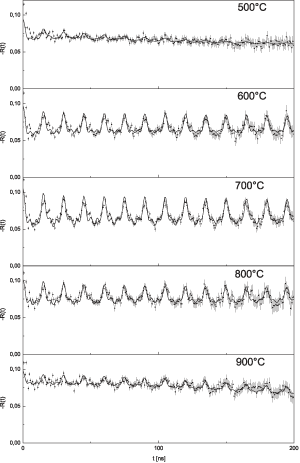
Several acceptor-donor pairs have been detected for a variety of group V atoms as a donor and indium (111In) as an acceptor in Si and Ge using the perturbed angular correlation (PAC) method [1,2]. In these measurements agreement has been reached that group III-V compensation in semiconductor is due to localized atomic bonding rather than to carrier recombination in the band model. Theoretical calculations of the EFGs at the site of the probe atom based on Korringa-Kohn-Rostoker (KKR) Green’s function method [3] have been in a good agreement with experiments. We extended the experiments to double donors and isoelectronic impurity to supply new values of EFG for further testing of the theoretical approach. Moreover, information has been extracted about the incorporation of the impurities in the host lattices.
In this effort a new quadrupole interaction frequency of νQ = 444(1)MHz (η = 0) is measured from tellurium implanted Si sample at annealing temperature near 550°C. The fraction of the pair gradually grows at higher annealing temperature and reaches a maximum of 37(2)% of the implanted nuclei at 700°C. According to orientation measurements the EFG lies along ⟨111⟩ crystal axis. Due to the absence of additional frequencies and the symmetry of the EFG around the ⟨111⟩ axis this defect is assigned to substitutional In-Te pair. Because of fast diffusive behavior of tellurium in silicon longer annealing time showed a quick dissociation of the pair.
At high dose implantations (2.5·1015 atom/cm2) of carbon in germanium two frequencies are detected. After annealing the sample at 450°C a frequency of 207(1)MHz (η = 0.16(3)) (site1) is measured. Orientation measurements showed, that this EFG is oriented along the ⟨111⟩ crystal axis. The fraction of this carbon related defect populated to a maximum value of 35(2)% at 600°C. After annealing at 650°C a new frequency of 500MHz (η = 0) appeared at the expense of the former. This frequency is certainly a new site (site2) of carbon in the substrate lattice and it remains dominant up to 850°C. According to infrared absorption and ion channeling study of substitutional carbon in germanium [4], a maximum of 31(3)% of the implanted carbon is reported to be at substitutional site at 450°C annealing temperature, but no substitutional fraction is observed above 700°C. Hence, this suggests that site2 in PAC measurements is not the result of the interaction of indium with substitutional carbon. Therefore, based on the ⟨111⟩ symmetry of the EFG and channeling information on substitutional carbon, site1 is assigned to indiumsubstitutional (near substitutional) carbon pairs. The most probable cause for the second frequency (site2) is a trapped C interstitial.
 |
[1] Th. Wichert and M.L. Swanson; J. Appl. Phys. 66(7) (1989) 3026
[2] D. Forkel, N. Achtziger, A. Baurichter, M. Deicher, S. Deubler, M. Puschmann, H.Wolf, W. Witthuhn; Nuclear Instruments and Methods in Physics Research B63 (1992) 217-220
[3] M. Settels, T. Korhonen, N. Papanikolaous, R. Zeller, P.H. Dederichs; Phys. Rev. Letters, 4369 (1999)
[4] L. Hoffmann, J.C. Bach, B. Bech Nielsen; Phys. Rev. B 11 (1997) 167